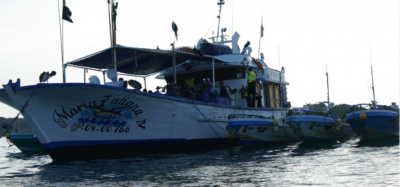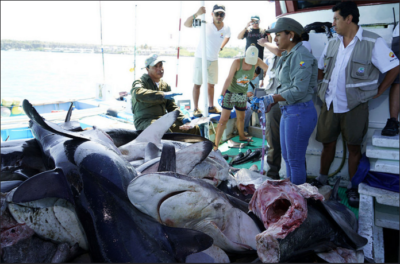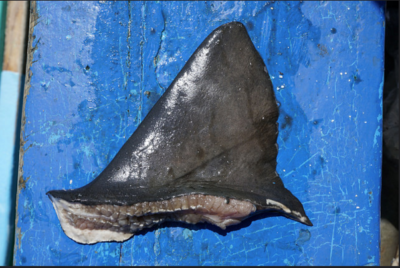By Silvia Sanchez Bor, April 14, 2016
 Late last week, a commercial fishing vessel and its six fiberglass boats were caught illegally fishing within the Galapagos Marine Reserve with a catch of 160 sharks and other fish. (Photo: Illegal fishing vessel Maria Tatiana IV (GNPS))
Late last week, a commercial fishing vessel and its six fiberglass boats were caught illegally fishing within the Galapagos Marine Reserve with a catch of 160 sharks and other fish. (Photo: Illegal fishing vessel Maria Tatiana IV (GNPS))
The Maria Tatiana IV, a fishing vessel from continental Ecuador entered the Galapagos Marine Reserve’s boundaries late Thursday night. Park rangers in the Galapagos National Park control center monitored its trajectory using electronic surveillance while patrol vessels sped towards the fishing vessel, having been alerted to this suspicious activity.
After a full day and night chasing the poachers at sea, the Galapagos park rangers and Ecuadorian Navy arrested 21 crew members and seized all seven boats, the long lines and the bounty of illegally caught species. These included 81 sharks—36 silky sharks, 24 blue sharks, 14 pelagic thresher sharks, six bigeye thresher sharks and one great white shark.
An estimated 73 million sharks are killed each year for the illegal shark fin trade around the world. To stop shark finning in the Galapagos, WildAid works with the Navy and park rangers to monitor the vast reserve and prevent illegal fishing. Last year, we updated the electronic surveillance system in the park’s control center to continue tracking all large fishing and tourism vessels. Since its installation in 2009, this technology has helped park rangers capture and sentence more than 100 industrial and artisanal fishing vessels, such as the Fer Mary I that was caught with 350 illegally caught sharks in its hold. This is the first illegal fishing arrest since the system update and since the announcement of a new marine sanctuary at Darwin and Wolf to protect sharks.
Although this technology has been a great tool for Galapagos park rangers and Navy officials, monitoring smaller vessels is especially challenging, which threatens mantas, sharks, sea turtles, and dolphins that get caught on fishing lines as bycatch or are illegally targeted for the lucrative wildlife trade.
Galapagos National Park rangers aboard the illegal fishing vessel (GNPS)
Earlier this year, Ecuador announced that all its vessels, no matter their size, will now be monitored in real time. The new legislation means that an additional 11,000 small vessels throughout the marine environment will now be tracked, which will further deter illegal fishing activity in the Galapagos Marine Reserve and along coastal Ecuador.We are working with the Ecuadorian Undersecretary of Marine and Coastal Resources and Ecuadorian Navy to implement this tracking at two pilot sites along coastal Ecuador: Machalilla National Park and Santa Clara Island.
WildAid has used its comprehensive marine protection model to decrease illegal fishing and protect nearly 3,000 marine species in the Galapagos Marine Reserve since 2002 thanks to the support of the Helmsley Charitable Trust, Conservation International, Mission Blue, IGTOA, the Walton Family Foundation and WWF.

Galapagos National Park rangers aboard the illegal fishing vessel (GNPS)

